The Havanese is a breed known for its enchanting personality and striking visual attributes. With a diverse array of standard and non-standard colors and patterns recognized by kennel clubs, these dogs exhibit a captivating spectrum of aesthetics. Beyond their coats, their small, well-built size, affectionate temperament, intelligence, and charming expressions make them cherished family members and beloved pets. Let’s delve into the distinctive coat colors and patterns, their rarity or commonality, and other characteristics that define the Havanese breed.

The Havanese is the national dog of Cuba.
©vauvau/iStock via Getty Images
Difference Between Standard and Non-Standard Coat Colors and Patterns
Kennel clubs play an important role in maintaining breed standards and preserving the integrity of purebred dogs. One aspect of this responsibility involves recognizing and distinguishing between standard and non-standard coat colors and patterns. This distinction is critical to ensure genetic health and adherence to breed standards.
Standard
Standard coat colors and patterns are those that conform to the official breed standard set by kennel clubs. These standards are meticulously crafted to define the consistent appearance of a breed about its genetic health, including the acceptable range of coat colors and patterns. For example, the American Kennel Club (AKC) and The Kennel Club (RKC) provide detailed descriptions of approved colors and markings for each breed they recognize. These standards are based on historical breed traits designed to maintain the breed’s genetic purity.
Non-Standard
Non-standard coat colors and patterns, on the other hand, deviate from the established breed standard. These colors and patterns can result from genetic mutations. Kennel clubs typically do not recognize dogs with non-standard coat colors or patterns. Reputable breeders with priorities of showing or maintaining pedigrees must adhere to the accepted standards to maintain the breed’s integrity.
It’s worth noting that non-standard coat colors and patterns can sometimes carry health risks. In some cases, these deviations may be associated with genetic disorders with or without increased susceptibility to certain health issues. Therefore, kennel clubs prioritize the preservation of standard coat colors and patterns to safeguard the overall health and well-being of the breed as well.
Overall, kennel clubs serve as preservers of breed standards, distinguishing between standard and non-standard coat colors and patterns to maintain purebred dogs’ genetic health and visual consistency. By upholding these standards, they ensure that breeds continue to conform to their traits for years to come.
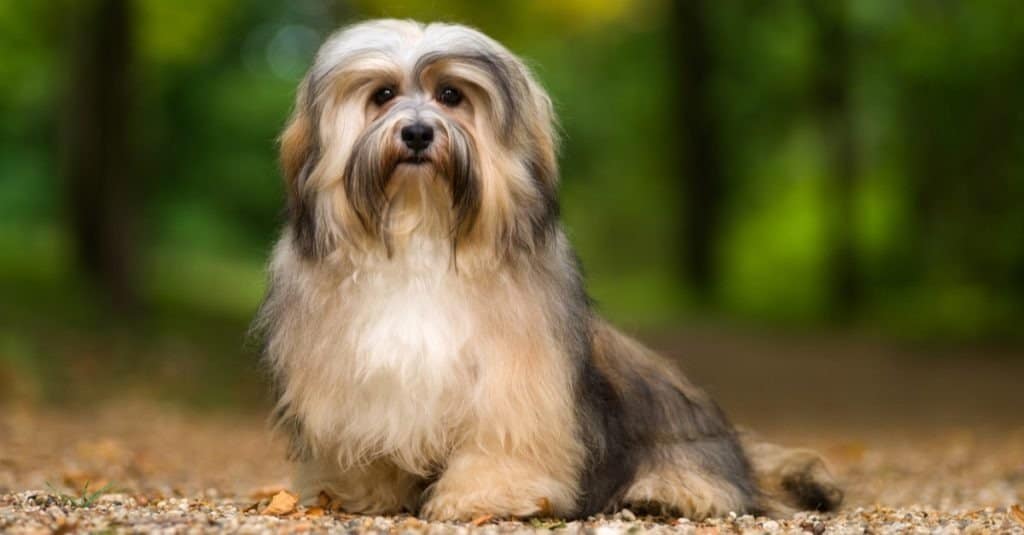
The AKC recognizes a large variety of standard and non-standard colors and patterns within the Havanese breed.
©Dorottya Mathe/Shutterstock.com
Havanese Coat Colors
The Havanese, a charming and affectionate breed known for its silky, flowing coat, can exhibit a wide variety of coat colors, some of which are standard and recognized by kennel clubs, while others are considered non-standard. Let’s explore the coat colors recognized by the American Kennel Club in detail.
Standard Coat Colors
White
White is one of the most recognized coat colors for Havanese. It’s a pure, pristine white, often described as glistening or pearly.
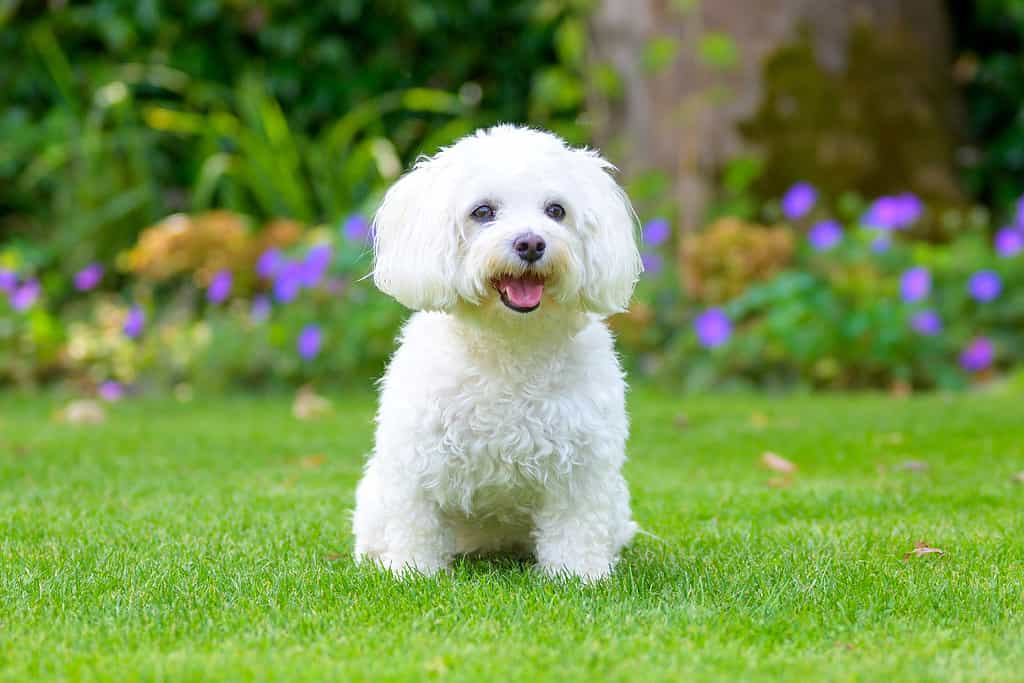
The white coat color in Havanese is a pure pearly white.
©mheim3011/iStock via Getty Images
Black
A solid black coat is sleek and shiny, creating a striking contrast against the Havanese’s expressive dark eyes.
Black Brindle
Black brindle features a black base coat with fine dark stripes, giving it a unique and captivating appearance.
Chocolate
Chocolate-colored Havanese have a rich, deep brown coat that exudes warmth and charm.
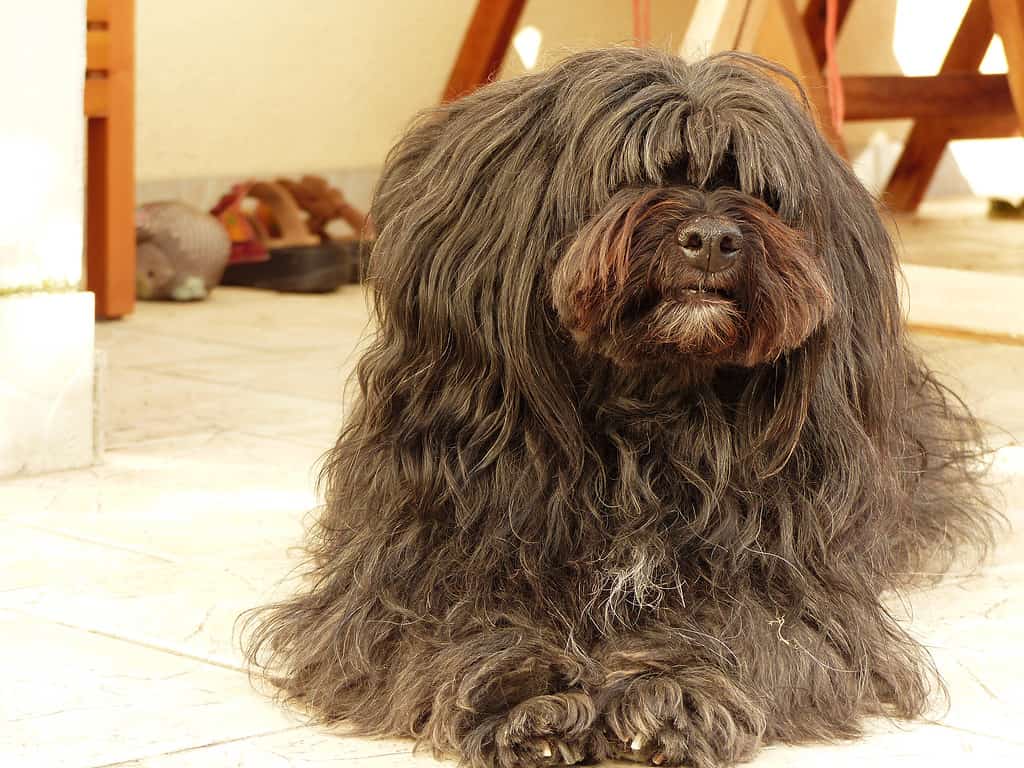
The chocolate coat color in Havanese includes shades of medium to dark brown.
©Emilien Schall/iStock via Getty Images
Cream
Cream coats are pale and soft, resembling the color of vanilla ice cream. This coat color gives off a visual energy of elegance and gentleness.
Fawn
The coat color fawn has a warm, tan color that radiates a friendly and approachable aura. It’s similar to the classic golden retriever look.
Gold
Gold coats are vibrant and lustrous, resembling the color of pure gold, which is a fitting match for this breed’s cheerful personality. Similar to fawn, it is a similar shade found in golden retrievers.
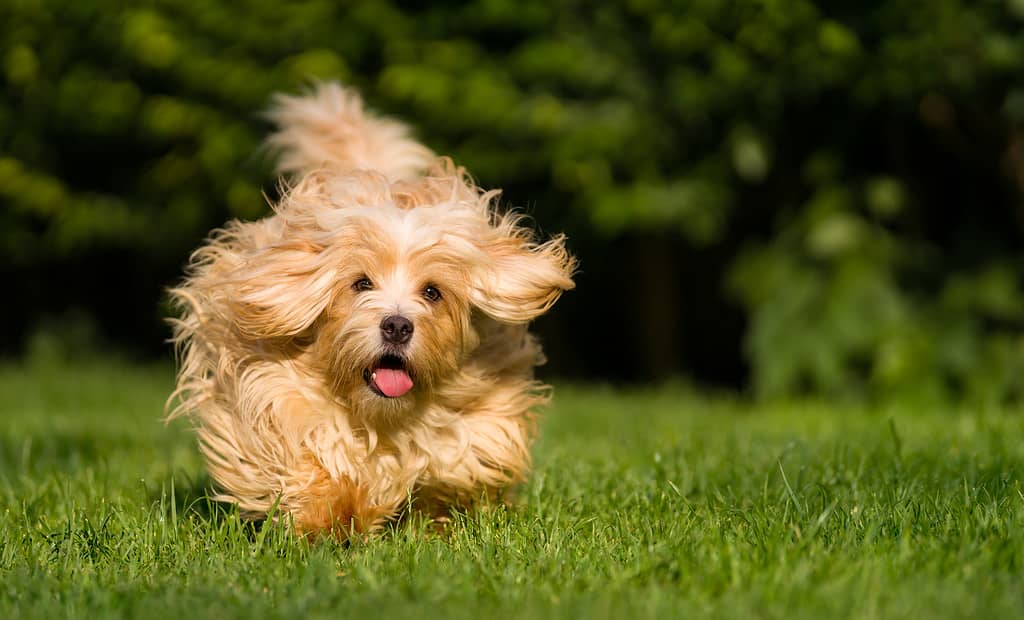
Havanese with gold coats resemble the iconic golden retriever in color.
©Dorottya_Mathe/iStock via Getty Images
Gold Brindle
The gold brindle coat color combines the classic gold base color with subtle dark stripes, adding depth and character to the coat.
Gold Sable
The gold sable coat color has a mix of gold and black hairs, creating a multi-toned, textured appearance.
Red
The red coat color exhibits a deep reddish-brown coat that conveys a visual energy of sassiness and playfulness.
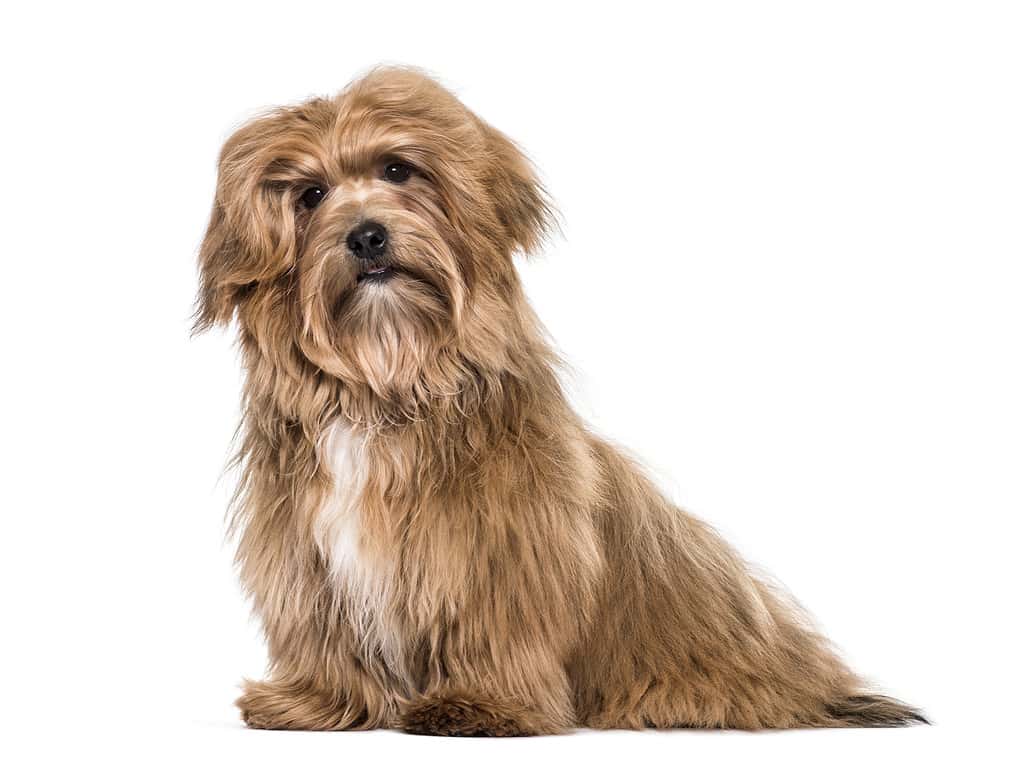
The red coat color is a reddish-brown color.
©GlobalP/iStock via Getty Images
Red Sable
The red sable coat color combines a red base coat with black hairs, resulting in a dynamic, eye-catching coat.
Red Brindle
The red brindle coat color blends a red base with darker stripes. It is a distinctive and lively look.
Silver
Silver-coated Havanese have a shimmering, silvery-white, or light gray coat that exudes visual sophistication and grace.

The silver coat color is a light to medium gray.
©vauvau/iStock via Getty Images
Silver Brindle
Silver brindle adds fine dark stripes to the silver base. This creates a captivating contrast.
Black and Tan
The black and tan coat color features a black coat with tan markings on specific areas, typically on the legs, eyebrows, and cheeks.
Black and Silver
The black and silver coat color combines a black coat with silver markings, creating an elegant and interestingly balanced appearance that is similar to the black and tan combination.
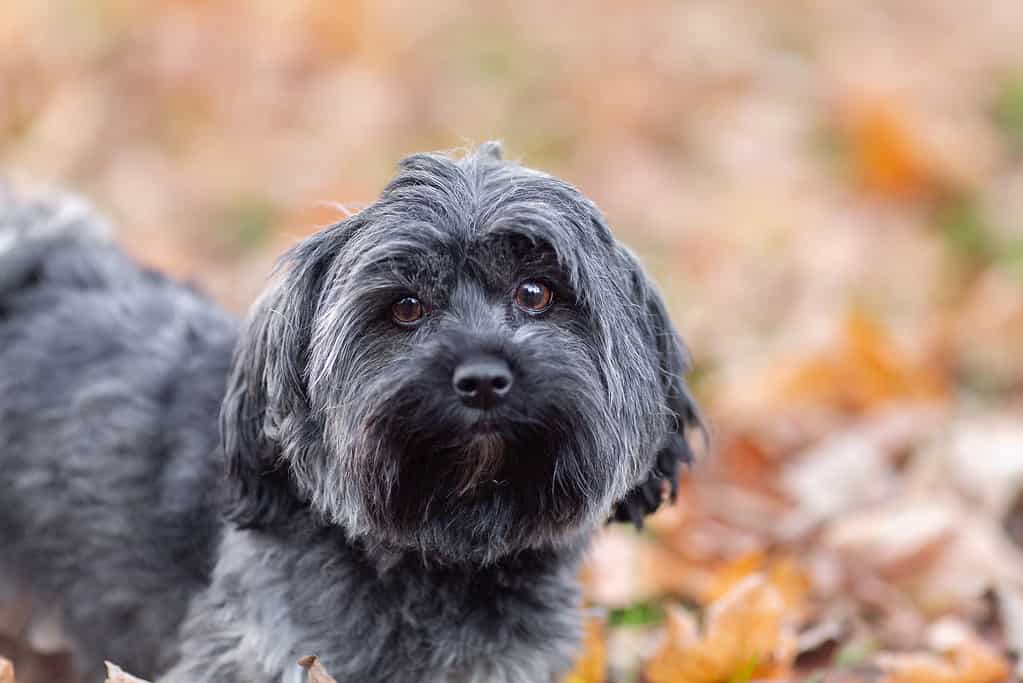
Black and silver is a darling coat color in the Havanese breed.
©Kanashi/iStock via Getty Images
Non-Standard Coat Colors
Blue
Blue Havanese have a steel-blue or bluish-gray coat, which, while lovely, is not recognized as a standard color by kennel clubs. Moreover, it is by far the rarest of all colors exhibited by the breed and results in the mutation of a specific gene that would result in a black coat.

In the Havanese breed, blue is the rarest coat color.
©Kanashi/iStock via Getty Images
Blue Brindle
Blue brindle combines the blue base with fine, darker stripes. Visually, this is a unique variation.
Fawn Brindle
The fawn brindle coat color features a fawn base color with dark stripes, creating an intriguing contrast.
Fawn Sable
The fawn sable coat color combines a fawn base coat and black hairs, resulting in a textured appearance.

The fawn sable color consists of a fawn base coat with black hairs.
©Dorottya_Mathe/iStock via Getty Images
Chocolate Sable
The chocolate sable coat color combines a chocolate base with black hairs. The black hairs add complexity to the coat.
Chocolate Brindle
The chocolate brindle coat color is a distinctive coat that combines a chocolate base with darker stripes.
Black and Tan Brindle
The black and tan brindle Havanese have black and tan markings along with dark stripes, creating a unique blend of colors.
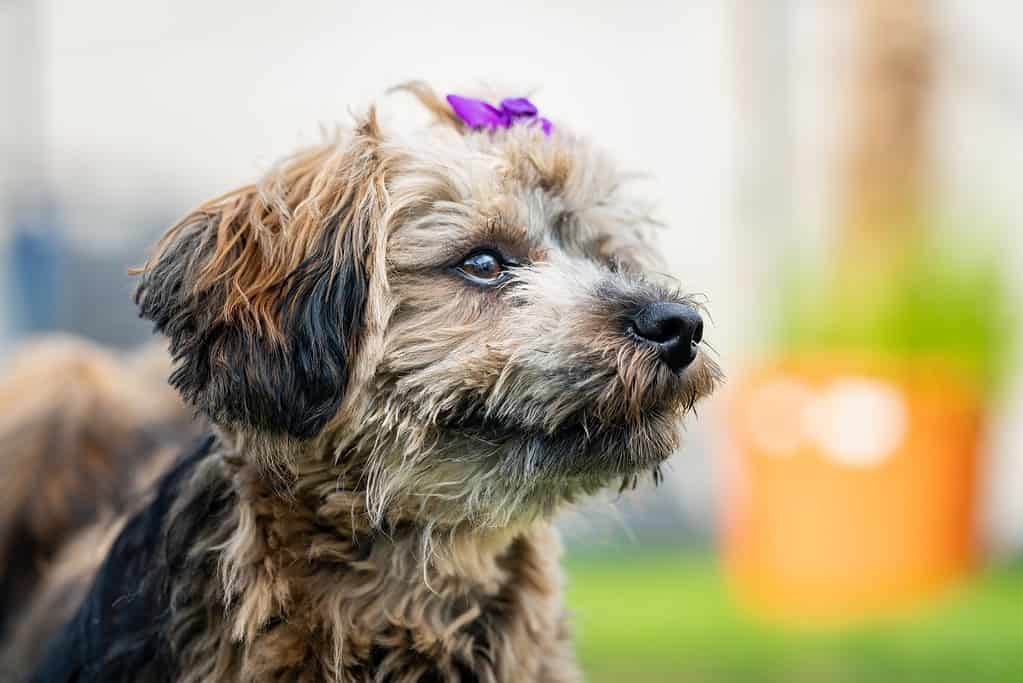
A Havanese with a black and tan brindle coat has a black and tan coat with darker stripes.
©Wirestock/iStock via Getty Images
Black and Silver Brindle
Similar to the standard black and silver, this variation adds darker stripes, which gives the coat more visual texture.
Silver Sable
Silver sable combines a silver base and black hairs. It is a striking coat and is not recognized by kennel clubs as a standard color.
In summary, the Havanese breed showcases a remarkable range of standard and non-standard coat colors, each contributing to the breed’s unique visual charm and personality. Furthermore, other coat colors exist within this breed. However, our list focuses on the colors recognized by the majority of kennel clubs.
Havanese Coat Patterns
Standard Coat Patterns
The Havanese possess only standard coat patterns that are recognized by kennel clubs. These coat patterns contribute to the breed’s unique visual appearance.
Parti-Color
The arti-color pattern exhibits a white base coat with patches of one or more colors, such as black, fawn, or red. These patches are often distributed randomly over the body, creating a distinct and eye-catching appearance. The colors are typically evenly distributed, and the white areas often dominate the coat. Furthermore, this pattern evokes a playful and lively vibe, reflecting the breed’s cheerful personality through visual appearance.
Irish Pied
The Irish Pied pattern features a coat with two coat colors, including white. The white must cover less than 50% of the body, typically on the belly, legs, and the tail tip on occasion. The secondary color is well-defined and can be black, brown, or another recognized color. Moreover, the Irish Pied pattern is quite rare amongst other breeds.
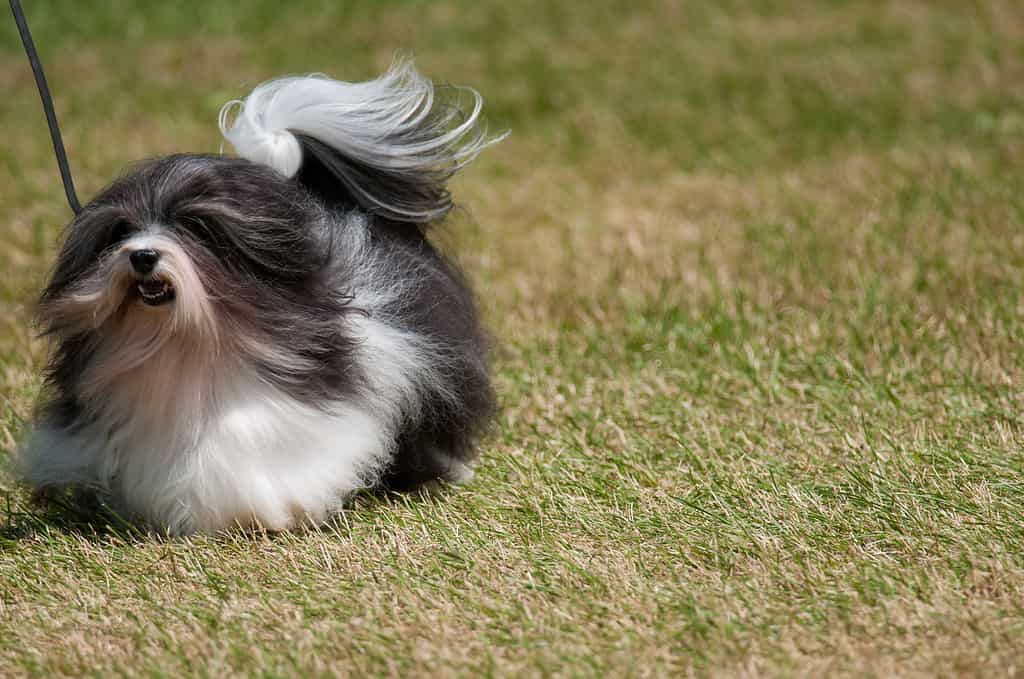
The Irish Pied pattern is only found in two breeds of dogs, including the Havanese.
©Kyle Reynolds/iStock via Getty Images
White Markings
Havanese with white markings have a primarily colored coat with well-defined white areas or markings. Furthermore, these white markings can appear on the paws, chest, muzzle, and tail tip. The contrast between the base color and the white markings creates a harmonious and visually appealing balance. White markings are quite common.
Cream Markings
Cream markings on a Havanese involve a primarily white coat with defined cream-colored areas. These creamy accents can be found on various parts of the body, including the ears, face, and legs. Moreover, this pattern adds a touch of softness and warmth to the dog’s appearance.
Silver Markings
Silver markings are characterized by a colored coat adorned with well-defined or subtle silver accents. These silver markings can be located on the legs, face, and other areas. Furthermore, the contrast between the base color and the silver markings imparts a regal and elegant look to the Havanese.
Tan Points
Havanese with tan points exhibit a predominantly colored coat with specific tan markings on the eyebrows, cheeks, legs, and paws. These tan points add depth and character to the overall appearance, enhancing the dog’s expressive facial features. Moreover, tan points can change color over time to silver or white.
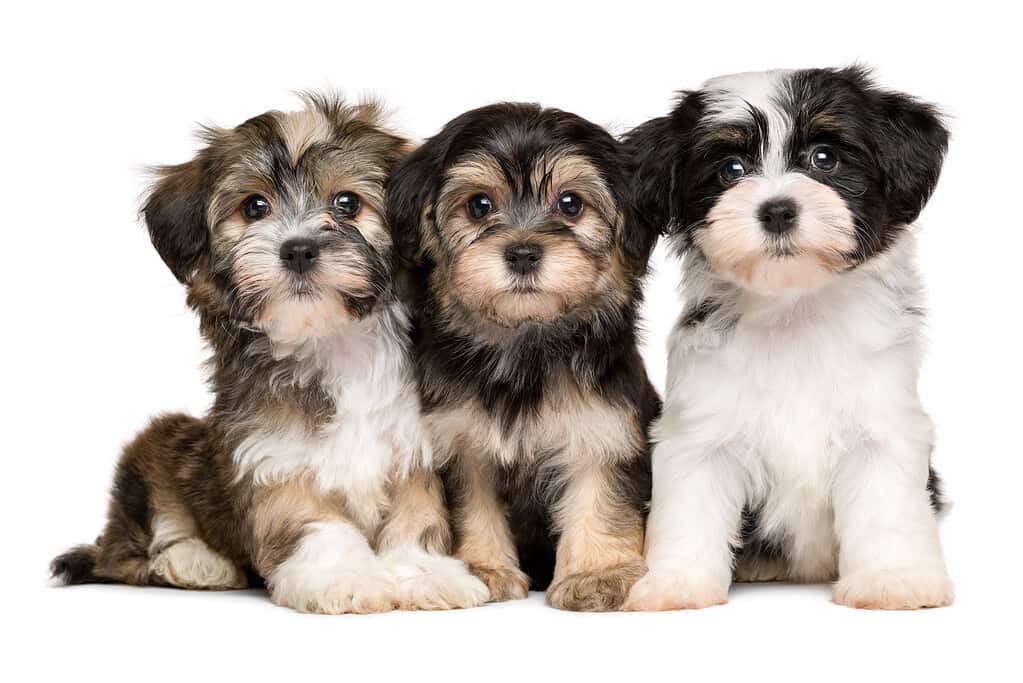
A Havanese with a tan point pattern (middle) will often exhibit a black coat with distinctive tan markings on the face, chest, legs, and paws.
©Dorottya_Mathe/iStock via Getty Images
Silver Points
Silver points involve a colored coat with distinctive silver markings on the legs, face, and other areas. Furthermore, tan points often change to silver points over time.
Parti Belton
Parti belton Havanese have a white base coat with colored ticking or speckling throughout. This creates a unique and visually striking pattern resembling a sprinkling of color over the white canvas. The overall effect is lively and charming, similar to a salt and pepper appearance, making the dog stand out.
Overall, the Havanese breed boasts a diverse range of standard coat patterns, each with its distinct characteristics and charm.
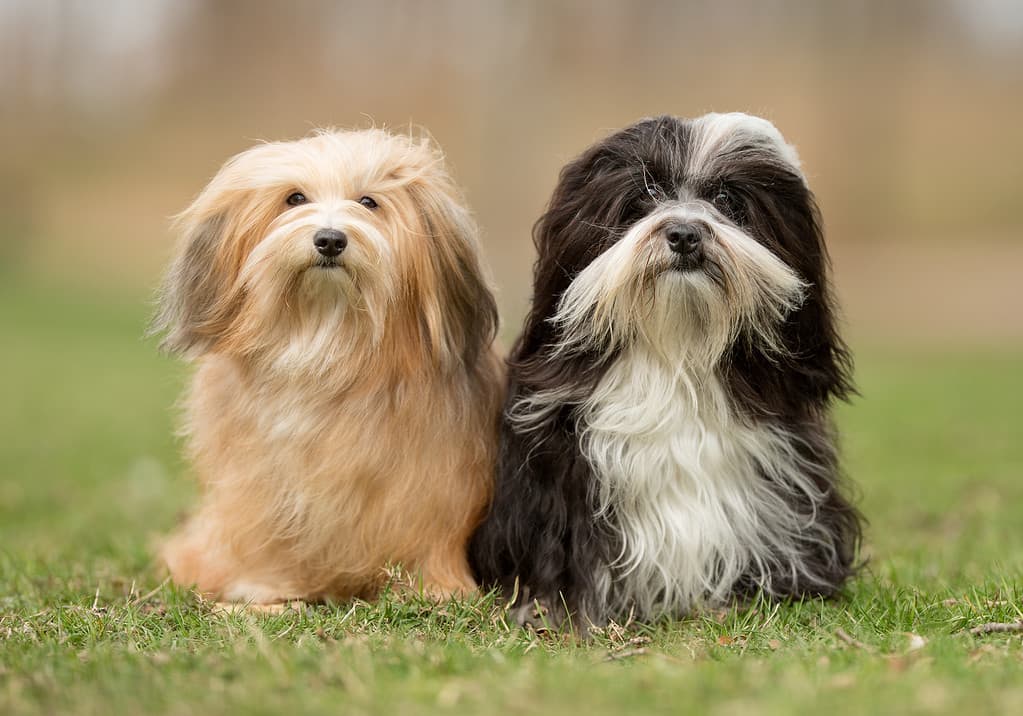
Havanese exhibit a large variety of coat colors and patterns.
©Bigandt_Photography/iStock via Getty Images
Havanese Standard Coat Colors Rarest to Most Common
Let’s delve into the rarity of Havanese standard coat colors, listing them from rarest to most common.
Rarest Havanese Coat Colors
Among the rarest Havanese coat colors, the blue brindle color combines a bluish-gray base with fine dark stripes. In contrast, the blue color lacks the additional black hairs. Both are uncommon yet captivating variations. Moreover, the striking combination of silver and sable, in addition to black and tan brindle, are some of the least commonly seen colors in Havanese.
Moderately Rare Havanese Coat Colors
Some of the moderately rare Havanese coat colors include chocolate sable, a mix of chocolate and black hairs, and fawn sable, which combines fawn and black hairs. Compared to other coat colors in this breed, these are relatively less common. Moreover, Havanese with chocolate brindle or fawn brindle colored coats are also less common than most but more common than the rarest of coat colors.
Moderately Common Havanese Coat Colors
While not as common as some coat colors, there are a handful of moderately common coat colors. Some include silver brindle, which combines silver with fine darker stripes, creating an appealing contrast, black and silver brindle, which adds dark stripes to the black and silver base, and solid silver, which is a lighter gray color. These colors are more frequently encountered than the rarer variations.
Most Common Havanese Coat Colors
Some of the most common coat colors exhibited by this breed are base colors of white, black, chocolate, cream, fawn, red, and gold. More complex colors include gold brindle and red brindle, which combine the base color with subtle darker stripes. Moreover, gold sable and red sable add black hairs to the already present base coat color. And finally, black and tan as well as black and silver, both of which are black base coats with tan or silver markings.
In summary, Havanese coat colors can vary in rarity, with some being rarer than others. Each color contributes to the unique charm of this beloved companion dog.
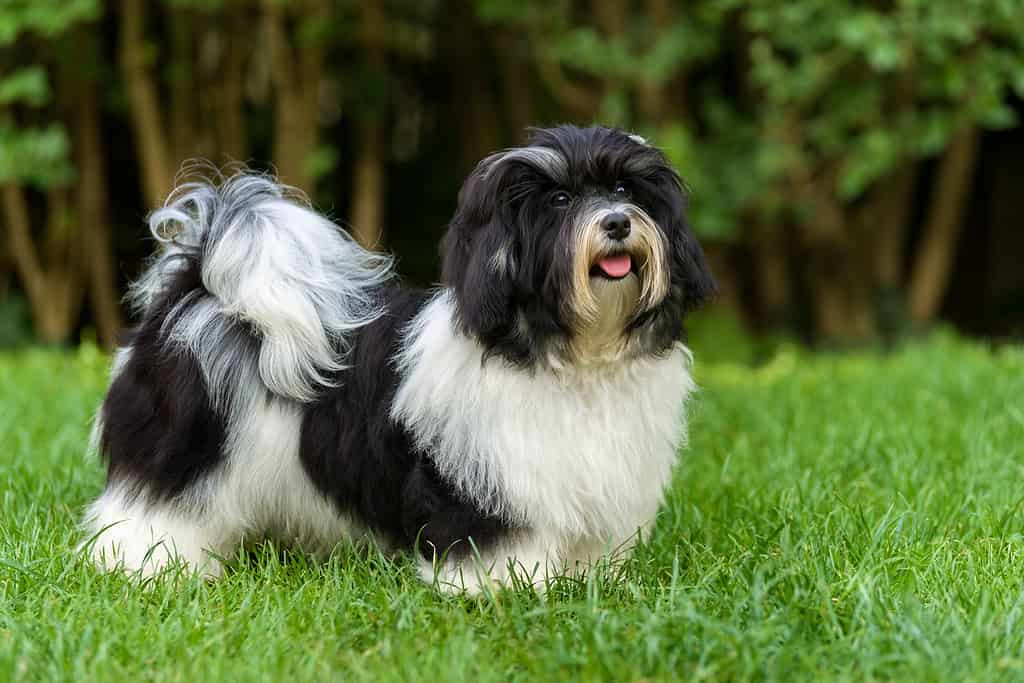
Havanese are a small breed of dog.
©Dorottya_Mathe/iStock via Getty Images
Other Havanese Characteristics
Havanese are a visually captivating small breed of dog with unique characteristics that set them apart. Furthermore, their appearance is a blend of elegance and charm, making them an eye-catching and delightful companion.
Size
Havanese are a small breed with a compact and well-proportioned build. Their height typically ranges between 8.5 to 11.5 inches (21.5 to 29 centimeters) at the shoulder, and they have shorter legs. Furthermore, their petite stature, adaptability, and low exercise needs make them an excellent choice for apartment living and families with limited space.
Weight
Havanese are lightweight but sturdy dogs. Their weight usually falls within the range of 7 to 13 pounds (3 to 6 kg). This feathery-light yet robust build contributes to their agility and playfulness.
Body Structure
The Havanese has a moderately long body with a straight topline from shoulders to tail. Their chest is well-developed, providing space for efficient lung capacity. Furthermore, their legs are straight and well-muscled, giving them stability and agility. The tail is carried gracefully over the back in a gentle curve, adding to their overall elegance. Moreover, their heads are broad and slightly rounded, with flat cheeks, a short protruding muzzle, and well-opened nostrils.
Head and Expression
Furthermore, the head of a Havanese is proportional to its body, with a slightly rounded skull and a well-defined stop. Their expressive eyes are large, almond-shaped, and dark brown. Visually, they convey warmth and intelligence. Moreover, the ears are medium-sized, set high, and gracefully folded, contributing to their endearing appearance.
Coat Texture
While we have previously explored Havanese coat colors and patterns, it’s worth mentioning their coat texture. Havanese have a double coat consisting of a soft, downy undercoat and a longer, silky outer coat. Furthermore, this luxurious combination adds to their visual appeal and gives them their distinctive, glamorous appearance. Regular grooming is necessary to keep their coats in pristine condition.
Facial Expression
One of the most captivating aspects of a Havanese is their facial expression. They have bright and alert eyes that convey curiosity and openness. Furthermore, their expressive faces often sport a gentle and endearing smile, similar to a teddy bear, which adds to their charm and makes them appear quite happy.
Movement
Havanese have a graceful and agile gait. Furthermore, their movement is quick, effortless, and smooth, with a slight bounce in their step, reflecting their cheerful and lively nature.
Colors (Excluding the Coat)
Beyond their coat colors and patterns, Havanese also have specific colorings on their noses and paw pads that correspond to their coat colors. For instance, Havanese with black coats usually have black noses and black paw pads, while those with chocolate-colored coats have matching brown noses and paw pads. This visual consistency contributes to their overall visual consistency and aesthetic appeal.
Havanese dogs possess a visually pleasing combination of colors, patterns, size, proportion, facial expression, texture, and movement, making them truly captivating. Furthermore, their compact yet sturdy build, expressive eyes, graceful gait, and charming expressions leave a lasting impression.
Temperament
Havanese are affectionate and sociable. They thrive on human companionship and are often referred to as “velcro dogs” because they love to be by their owner’s side. This affectionate breed forms strong bonds with its family members and enjoys participating in daily activities. Their gentle disposition makes them excellent choices for families, including those with children. They are patient, which is essential when dealing with energetic kids. Moreover, they are naturally playful, friendly, adaptable, and open to strangers (human or animal), making them a sociable breed.
Havanese dogs are affectionate and known for their intelligence and adaptability. They are quick learners, eager to please, and excel in obedience training. In addition, their desire to please their owners makes them highly trainable and responsive to positive reinforcement methods.
Furthermore, though they have moderate to low energy levels, Havanese are playful and lively, making them great playmates for children and adults alike. They have a penchant for entertaining their families with their charming antics, often displaying a sense of humor that endears them to everyone.
Intelligence
Havanese are not only affectionate but also highly intelligent. They are quick learners and problem solvers. Moreover, they have a natural curiosity and enjoy mentally stimulating activities such as puzzle toys and interactive games. While intelligent, they only have moderate to low mental stimulation needs.
Finally, their intelligence extends to their ability to read human emotions and respond with empathy. Moreover, this emotional intelligence makes them excellent therapy dogs, providing comfort and companionship to those in need.

Havanese make great family companions.
©Sandra Huber/Shutterstock.com
Havanese as Family Pets
This breed can be a great family pet for various reasons. Their small size makes them adaptable to almost any home environment. Moreover, they are generally not excessive barkers, which can be an advantage for urban living.
Their affectionate and sociable nature means they get along well with other pets, making them great additions to households with multiple animals. Their playful and patient disposition also ensures they are often excellent playmates for children.
Havanese dogs do require regular grooming to maintain their luxurious coats. However, they are a low-shedding breed, which can be a benefit for allergy sufferers.
The Havanese breed is more than just its captivating coat patterns. Its temperament, intelligence, variety of other characteristics, and role as a family pet make it a cherished and versatile companion. Furthermore, their affectionate nature and adaptability ensure they bring joy and love to their owners’ lives, making them a breed worth celebrating.
Summary of Havanese Colors: Most Common to Rarest
| Most Common to Rarest | Havanese Colors |
|---|---|
| 1 | White |
| 2 | Black |
| 3 | Black Brindle |
| 4 | Chocolate |
| 5 | Cream |
| 6 | Fawn |
| 7 | Gold |
| 8 | Gold Brindle |
| 9 | Gold Sable |
| 10 | Red |
| 11 | Red Sable |
| 12 | Red Brindle |
| 13 | Silver |
| 14 | Silver Brindle |
| 15 | Black and Tan |
| 16 | Black and Silver |
| 17 | Blue |
| 18 | Blue Brindle |
| 19 | Fawn Brindle |
| 20 | Fawn Sable |
| 21 | Chocolate Sable |
| 22 | Chocolate Brindle |
| 23 | Black and Tan Brindle |
| 24 | Black and Silver Brindle |
| 25 | Silver Sable |
The photo featured at the top of this post is © vauvau/iStock via Getty Images
Thank you for reading! Have some feedback for us? Contact the AZ Animals editorial team.







